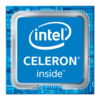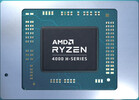Intel Celeron 5305U vs AMD Ryzen 7 4800H vs AMD Ryzen 9 4900H
Intel Celeron 5305U
► remove from comparison
The Intel Celeron 5305U is a low-power dual-core SoC for laptops, based on the Comet Lake architecture, which was introduced in 2020. Compared to Kaby Lake and Whiskey Lake, there are apparently no differences with Comet Lake apart from the two additional cores in the Top model Core i7-10710U. The processor is still manufactured using the mature 14nm process (14nm++ like Whiskey Lake). The processor cores clock at a fixed 2.3 GHz (no Turbo) and also only offer 2 threads (no HyperThreading). Compared to the more powerful Core i3, i5 and i7 variants, the Celeron does not offer SSE (2) support.
You can find more information about the Comet Lake architecture and the available processors on our Comet Lake topic page.
According to Intel, the integrated graphics card is called Intel UHD Graphics, but is an old Intel UHD Graphics 610. It is clocked in the Celeron 5205U at 300 - 900 MHz and is only sufficient for very demanding games. The CPU also offers an integrated DDR4-2666 / LPDDR4x 2933 / LPDDR3-2133 dual-channel memory controller as well as VP9 and H.265 video decoder and encoder.
Performance
The performance of the Celeron 5305U is in the lowest entry-level class of notebook processors in 2020. Due to the lack of Turbo and only 2 cores, the CPU cannot score points in either single-core or multi-core tasks. The processor is therefore only suitable for undemanding tasks such as surfing with a few tabs and office tasks.
The power consumption and performance can be set from 15 to 12.5 watts by the notebook manufacturer via cTDP-down. However, the processor then only runs at 800 MHz and significantly reduced performance. Even at 15 watts, however, the processor is suitable for thin and light notebooks.
AMD Ryzen 7 4800H
► remove from comparison
The AMD Ryzen 7 4800H is a Renoir APU designed for larger, more powerful laptops with room for better termals. The Ryzen features eight Zen 2 cores running at 2.9 GHz (base clock speed) to 4.2 GHz (Boost). The CPU also has 8 MB of L3 cache and a Vega series integrated GPU. Thread-doubling SMT tech is enabled in this processor, allowing for up to 16 concurrent processing threads.
Architecture
Ryzen 7 4800H is manufactured on the modern 7 nm TSMC process and in part thanks to this fact AMD promises an up to 2x higher performance-per-watt figure compared to Ryzen 3000 series mobile APUs. This isn't the only noteworthy change however as Zen 2 architecture is leagues ahead of the outgoing Zen+ when it comes to single-core performance. Renoir family processors feature up to 8 CPU cores compared to 4 cores of the previous generation mobile AMD CPUs.
A 4800H will work with dual-channel DDR4-3200 or quad-channel LPDDR4-4266 RAM. The important difference between desktop Ryzen 4000 and mobile Ryzen 4000 processors is that the latter do not have PCI-Express 4.0 support, meaning those blazing-fast NVMe SSDs will be limited to a throughput of 3.9 GB/s.
The Ryzen 7 gets soldered straight to the motherboard (FP6 socket) and is thus not user-replaceable. Please go to our Renoir processor family hub for more information on these CPUs.
Performance
The average 4800H in our database is in the same league as the Core i7-11850H, the Core i7-1360P and also the Ryzen 7 PRO 6850U, as far as multi-thread benchmark scores are concerned. This highlights just how great of a job Renoir designers did, back in the day.
Thanks to its decent cooling solution and a long-term power limit of 45 W, the MSI Alpha 17 A4DEK is among the fastest laptops built around the 4800H that we know of. It can be more than 20% faster in CPU-bound workloads than the slowest system featuring the same chip in our database, as of August 2023.
Graphics
Ryzen 7 4800H features the Radeon RX Vega 7, a 7 CU integrated graphics adapter running at up to 1,600 MHz. The iGPU's underlying architecture is fairly old as of 2021, yet its 448 shaders will let you play many games of 2020 and 2021 as long as you stick to reasonable resolutions and presets. F1 2021 runs well at medium quality, 1080p resolution, to give you an example. A Vega 7 can be as fast as a GeForce GTX 1050 Max-Q, or as slow as an 80 EU Iris Xe; this depends on the benchmark as well as on cooling system performance and TDP settings of a laptop as mentioned above. As the iGPU has no VRAM of its own, it is paramount that fast system RAM is used.
The Vega definitely supports UHD 2160p monitors at 60 Hz. This iGPU is capable of hardware decoding AVC, HEVC and VP9-encoded videos. There is no AV1 support to be found here though. Such a video will have to be SW-decoded leading to much lower energy efficiency.
Power consumption
This Ryzen 7 series chip has a default TDP (also known as the long-term power limit) of 45 W. Laptop makers are allowed to change that to anything between 35 W and 54 W, with clock speeds and performance changing accordingly as a result. The Ryzen 7 4800HS is a 35 W edition of the Ryzen 7 4800H that trades away a bit of performance for lower power consumption. In both cases, an active cooling solution is a must.
Both the 4800H and the 4800HS are built with TSMC's 7 nm process for decent, as of late 2022, energy efficiency.
AMD Ryzen 9 4900H
► remove from comparison
The AMD Ryzen 9 4900H is a mobile SoC for big laptops based on the Renoir architecture. At the time of announcement in March 2020 it is the fastest model of the 4000H series. The R9 4900H integrates all eight cores based on the Zen 2 microarchitecture. They are clocked at 3.3 (guaranteed base clock) to 4.4 GHz (Turbo) and support SMT / Hyperthreading (16 threads). The chip is manufactured in the modern 7 nm process at TSMC and partly thanks to it AMD advertises a 2x improved performance per Watt for the Renoir chips
According to our information, the Ryzen 9 4900H is only slightly faster than the Ryzen 7 4800H. The CPU is clocked 400 MHz (base +14%) to 200 MHz (boost +5%) higher, but the gains greatly depend on the cooling and TDP settings. Compared to Intel chips, the i9-9980HK top model should be comparable. That means the Ryzen 9 4900H should be able to handle all demanding tasks and gaming.
In addition to the eight CPU cores, the APU also integrates a Radeon RX Vega 8 integrated graphics card with 8 CUs. The dual channel memory controller supports DDR4-3200 and energy efficient LPDDR4-4266 RAM. Furthermore, 12 MB level 3 cache can be found on the chip. See our hub page on the Renoir Processors for more information.
The TDP of the APU is specified at 45 Watt (default). That means the chip is intended for big and relatively heavy laptops.
| Model | Intel Celeron 5305U | AMD Ryzen 7 4800H | AMD Ryzen 9 4900H | ||||||||||||||||||||||||||||||||||||||||||||||||||||||||||||||||
| Codename | Comet Lake-U | Renoir-H (Zen 2) | Renoir-H (Zen 2) | ||||||||||||||||||||||||||||||||||||||||||||||||||||||||||||||||
| Series | Intel Comet Lake | AMD Renoir (Ryzen 4000 APU) | AMD Renoir (Ryzen 4000 APU) | ||||||||||||||||||||||||||||||||||||||||||||||||||||||||||||||||
| Series: Renoir (Ryzen 4000 APU) Renoir-H (Zen 2) |
|
|
| ||||||||||||||||||||||||||||||||||||||||||||||||||||||||||||||||
| Clock | 2300 MHz | 2900 - 4200 MHz | 3300 - 4400 MHz | ||||||||||||||||||||||||||||||||||||||||||||||||||||||||||||||||
| Cores / Threads | 2 / 2 | 8 / 16 | 8 / 16 | ||||||||||||||||||||||||||||||||||||||||||||||||||||||||||||||||
| TDP | 15 Watt | 45 Watt | 45 Watt | ||||||||||||||||||||||||||||||||||||||||||||||||||||||||||||||||
| Technology | 14 nm | 7 nm | 7 nm | ||||||||||||||||||||||||||||||||||||||||||||||||||||||||||||||||
| max. Temp. | 100 °C | 105 °C | 105 °C | ||||||||||||||||||||||||||||||||||||||||||||||||||||||||||||||||
| Socket | BGA1528 | FP6 | FP6 | ||||||||||||||||||||||||||||||||||||||||||||||||||||||||||||||||
| Features | LPDDR3-2133/DDR4-2400 RAM, PCIe 2, 4 GT/s bus, MMX, SSE, SSE2, SSE3, SSSE3, SSE4.1, SSE4.2, AVX, AVX2, BMI2, ABM, FMA, ADX, VMX, SMEP, SMAP, MPX, EIST, TM1, TM2, SST, AES-NI, RDRAND, RDSEED, SGX | DDR4-3200/LPDDR4-4266 RAM, PCIe 3, MMX, SSE, SSE2, SSE3, SSSE3, SSE4A, SSE4.1, SSE4.2, AVX, AVX2, BMI2, ABM, FMA, ADX, SMEP, SMAP, SMT, CPB, AES-NI, RDRAND, RDSEED, SHA, SME | DDR4-3200/LPDDR4-4266 RAM, PCIe 3, MMX (+), SSE, SSE2, SSE3, SSSE3, SSE4.1, SSE4.2, SSE4A, AES, AVX, AVX2, FMA, SHA | ||||||||||||||||||||||||||||||||||||||||||||||||||||||||||||||||
| iGPU | Intel UHD Graphics 610 (300 - 900 MHz) | AMD Radeon RX Vega 7 ( - 1600 MHz) | AMD Radeon RX Vega 8 (Ryzen 4000/5000) ( - 1750 MHz) | ||||||||||||||||||||||||||||||||||||||||||||||||||||||||||||||||
| Architecture | x86 | x86 | x86 | ||||||||||||||||||||||||||||||||||||||||||||||||||||||||||||||||
| $107 U.S. | |||||||||||||||||||||||||||||||||||||||||||||||||||||||||||||||||||
| Announced | |||||||||||||||||||||||||||||||||||||||||||||||||||||||||||||||||||
| Manufacturer | ark.intel.com | www.amd.com | www.amd.com | ||||||||||||||||||||||||||||||||||||||||||||||||||||||||||||||||
| L1 Cache | 512 KB | 512 KB | |||||||||||||||||||||||||||||||||||||||||||||||||||||||||||||||||
| L2 Cache | 4 MB | 4 MB | |||||||||||||||||||||||||||||||||||||||||||||||||||||||||||||||||
| L3 Cache | 8 MB | 8 MB |
Benchmarks
Average Benchmarks Intel Celeron 5305U → 0% n=0
Average Benchmarks AMD Ryzen 7 4800H → 0% n=0
Average Benchmarks AMD Ryzen 9 4900H → 0% n=0
* Smaller numbers mean a higher performance
1 This benchmark is not used for the average calculation













